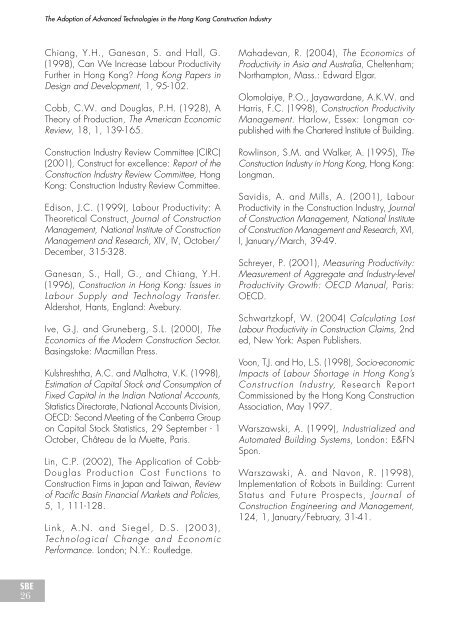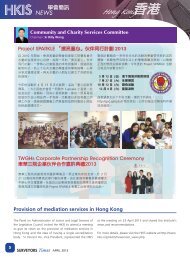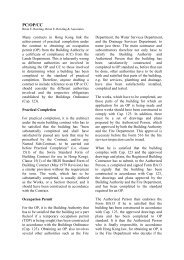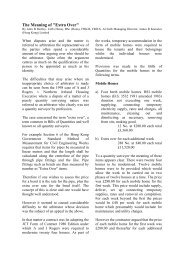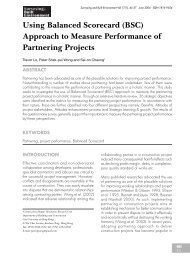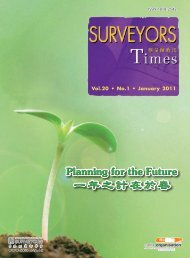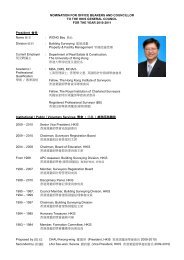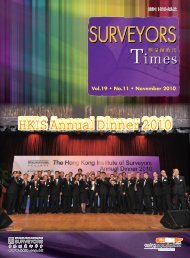Lai-san Kwok and Eileen Mary Hastings - Hong Kong Institute of ...
Lai-san Kwok and Eileen Mary Hastings - Hong Kong Institute of ...
Lai-san Kwok and Eileen Mary Hastings - Hong Kong Institute of ...
Create successful ePaper yourself
Turn your PDF publications into a flip-book with our unique Google optimized e-Paper software.
The Adoption <strong>of</strong> Advanced Technologies in the <strong>Hong</strong> <strong>Kong</strong> Construction IndustryChiang, Y.H., Gane<strong>san</strong>, S. <strong>and</strong> Hall, G.(1998), Can We Increase Labour ProductivityFurther in <strong>Hong</strong> <strong>Kong</strong>? <strong>Hong</strong> <strong>Kong</strong> Papers inDesign <strong>and</strong> Development, 1, 95-102.Cobb, C.W. <strong>and</strong> Douglas, P.H. (1928), ATheory <strong>of</strong> Production, The American EconomicReview, 18, 1, 139-165.Construction Industry Review Committee (CIRC)(2001), Construct for excellence: Report <strong>of</strong> theConstruction Industry Review Committee, <strong>Hong</strong><strong>Kong</strong>: Construction Industry Review Committee.Edison, J.C. (1999), Labour Productivity: ATheoretical Construct, Journal <strong>of</strong> ConstructionManagement, National <strong>Institute</strong> <strong>of</strong> ConstructionManagement <strong>and</strong> Research, XIV, IV, October/December, 315-328.Gane<strong>san</strong>, S., Hall, G., <strong>and</strong> Chiang, Y.H.(1996), Construction in <strong>Hong</strong> <strong>Kong</strong>: Issues inLabour Supply <strong>and</strong> Technology Transfer.Aldershot, Hants, Engl<strong>and</strong>: Avebury.Ive, G.J. <strong>and</strong> Gruneberg, S.L. (2000), TheEconomics <strong>of</strong> the Modern Construction Sector.Basingstoke: Macmillan Press.Kulshreshtha, A.C. <strong>and</strong> Malhotra, V.K. (1998),Estimation <strong>of</strong> Capital Stock <strong>and</strong> Consumption <strong>of</strong>Fixed Capital in the Indian National Accounts,Statistics Directorate, National Accounts Division,OECD: Second Meeting <strong>of</strong> the Canberra Groupon Capital Stock Statistics, 29 September - 1October, Château de la Muette, Paris.Lin, C.P. (2002), The Application <strong>of</strong> Cobb-Douglas Production Cost Functions toConstruction Firms in Japan <strong>and</strong> Taiwan, Review<strong>of</strong> Pacific Basin Financial Markets <strong>and</strong> Policies,5, 1, 111-128.Link, A.N. <strong>and</strong> Siegel, D.S. (2003),Technological Change <strong>and</strong> EconomicPerformance. London; N.Y.: Routledge.Mahadevan, R. (2004), The Economics <strong>of</strong>Productivity in Asia <strong>and</strong> Australia, Cheltenham;Northampton, Mass.: Edward Elgar.Olomolaiye, P.O., Jayawardane, A.K.W. <strong>and</strong>Harris, F.C. (1998), Construction ProductivityManagement. Harlow, Essex: Longman copublishedwith the Chartered <strong>Institute</strong> <strong>of</strong> Building.Rowlinson, S.M. <strong>and</strong> Walker, A. (1995), TheConstruction Industry in <strong>Hong</strong> <strong>Kong</strong>, <strong>Hong</strong> <strong>Kong</strong>:Longman.Savidis, A. <strong>and</strong> Mills, A. (2001), LabourProductivity in the Construction Industry, Journal<strong>of</strong> Construction Management, National <strong>Institute</strong><strong>of</strong> Construction Management <strong>and</strong> Research, XVI,I, January/March, 39-49.Schreyer, P. (2001), Measuring Productivity:Measurement <strong>of</strong> Aggregate <strong>and</strong> Industry-levelProductivity Growth: OECD Manual, Paris:OECD.Schwartzkopf, W. (2004) Calculating LostLabour Productivity in Construction Claims, 2nded, New York: Aspen Publishers.Voon, T.J. <strong>and</strong> Ho, L.S. (1998), Socio-economicImpacts <strong>of</strong> Labour Shortage in <strong>Hong</strong> <strong>Kong</strong>’sConstruction Industry, Research ReportCommissioned by the <strong>Hong</strong> <strong>Kong</strong> ConstructionAssociation, May 1997.Warszawski, A. (1999), Industrialized <strong>and</strong>Automated Building Systems, London: E&FNSpon.Warszawski, A. <strong>and</strong> Navon, R. (1998),Implementation <strong>of</strong> Robots in Building: CurrentStatus <strong>and</strong> Future Prospects, Journal <strong>of</strong>Construction Engineering <strong>and</strong> Management,124, 1, January/February, 31-41.SBE26
Surveying <strong>and</strong> Built Environment Vol 17(1), 27-34 June 2006 ISSN 1816-9554<strong>Hong</strong> <strong>Kong</strong> Real Estate Agency Industry:Survey on Important Marketing Factor<strong>san</strong>d Br<strong>and</strong>ing Attributes in light <strong>of</strong>Service Intangibility<strong>Lai</strong>-<strong>san</strong> <strong>Kwok</strong> <strong>and</strong> <strong>Eileen</strong> <strong>Mary</strong> <strong>Hastings</strong> 1ABSTRACTThe aim <strong>of</strong> the study is to investigate the attitude <strong>of</strong> real estate agency companies in <strong>Hong</strong> <strong>Kong</strong>towards marketing factors which drive the customers’ service employment decision <strong>and</strong> attitudetowards br<strong>and</strong>ing in light <strong>of</strong> service intangibility. Due to the nature <strong>of</strong> the real estate agency industry<strong>and</strong> service intangibility, it is found that personnel is one <strong>of</strong> the crucial factors which drive thecustomers’ willingness to buy the service. Br<strong>and</strong>ing, on the other h<strong>and</strong>, being an indicator <strong>of</strong> servicequality, can be a way <strong>of</strong> marketing real estate agency services. In establishment <strong>of</strong> a service br<strong>and</strong>,personalized service <strong>and</strong> service quality play an important role.KEYWORDSMarketing Factors, Br<strong>and</strong>ing AttributesBACKGROUND OF THE STUDYReal estate agency companies serve asmiddlemen between parties. They help the buyer<strong>san</strong>d lessees to identify potential properties whichsuit their dem<strong>and</strong>. On the other h<strong>and</strong>, they assistthe developers, property owners or leasers tosearch for interested parties. The estate agentswill perform all sorts <strong>of</strong> tasks including introducinga client, arranging viewing <strong>of</strong> a property,negotiating terms, arranging signing <strong>of</strong> Sales <strong>and</strong>Purchase Agreement <strong>and</strong> explaining the termsin the agreement etc. When transaction is closed,the estate agent is entitled to receivecommissions. The commission is a kind <strong>of</strong> servicecharge.The real estate agency companies serve to1Department <strong>of</strong> Real Estate <strong>and</strong> Construction, The University <strong>of</strong><strong>Hong</strong> <strong>Kong</strong>reduce transaction cost involved in propertytransaction, like finding interested parties,identifying potential property, conductnegotiation etc. They act as a bridge betweensupply <strong>and</strong> dem<strong>and</strong> which facilitates thetransaction. In January 2005, there were a total<strong>of</strong> 3166 registered estate agency shops <strong>and</strong>8827 registered estate agents according to thestatistic <strong>of</strong> Estate Agents Authority. Real estateagency is a highly competitive industry. In orderto st<strong>and</strong> out in the market, one has to use variousstrategies so as to enjoy part <strong>of</strong> the market share.Marketing is one <strong>of</strong> the choices.Appropriate marketing strategy enables thecustomers to know the competitive advantages<strong>of</strong> the real estate agency companies. It shouldbe clarified that marketing is not purelyadvertisements <strong>and</strong> promotions. It is a processinvolves perception, underst<strong>and</strong>ing, stimulation<strong>and</strong> satisfaction <strong>of</strong> the target markets’ dem<strong>and</strong>.SBE27
<strong>Hong</strong> <strong>Kong</strong> Real Estate Agency Industry:Survey on Important Marketing Factors <strong>and</strong> Br<strong>and</strong>ing Attributes in light <strong>of</strong> Service IntangibilityIt channels the companies’ resources to meet thedem<strong>and</strong>. Therefore, marketing <strong>of</strong> real estateagency companies are not purely advertisingthe property available <strong>and</strong> persuade thecustomers to buy.Marketing can channel the real estate agencyservices to meet the dem<strong>and</strong> <strong>of</strong> the customers.However real estate agency is a service provisionindustry. It differs from goods like can <strong>of</strong> drink<strong>and</strong> set <strong>of</strong> computer. Real estate agency serviceis intangible in nature. It is difficult to comparethe quality <strong>and</strong> price like what the customers didwhen they buy goods. It is hard for the customersto evaluate <strong>and</strong> compare something which isintangible. It is difficult to tell which real estateagency is better. This is not just the challengesfaced by the customers, but the real estateagency themselves.In this competitive industry, the real estate agencycompanies have to seek ways to attractcustomers. They have to make the customersknow <strong>and</strong> “feel” that their services are betterthan that <strong>of</strong> their competitors. But intangibility <strong>of</strong>service makes marketing more difficult. Thecompany, therefore, has to rely on some othertangible cues such as personnel, price, <strong>and</strong>facilities etc. to make service quality more easilyassessable. By utilizing tangible cues, it will beeasier to channel information to the customer<strong>san</strong>d more importantly, to persuade the customersin service employment. As a result marketingbecomes important for the real estate agencycompanies.In marketing real estate agency service, benefitsshould be conferred to the customers. Benefitsshall be conferred by some attributes whichwould affect the customers’ choice.Furthermore, br<strong>and</strong>ing exists in goods industry,for example there are popular fashion br<strong>and</strong> <strong>and</strong>food br<strong>and</strong>. Service br<strong>and</strong> is not new in otherindustry like banking <strong>and</strong> finance. In real estateagency industry, service br<strong>and</strong>s do exist. Whenthe customers heard <strong>of</strong> a service br<strong>and</strong>, theywill immediately have a perception on thecompany <strong>and</strong> on the service as well. Servicebr<strong>and</strong> in fact serves to make intangible servicetangible. It <strong>of</strong>fers the real estate agency a marketposition. There are lots <strong>of</strong> factors contributing toa br<strong>and</strong>. All the br<strong>and</strong>ing attributes contribute todifferent extent in a br<strong>and</strong>. Br<strong>and</strong>ing attributeslike expertise, company reputation <strong>and</strong> price etc.channel the benefits to the customers. Thesebenefits drive the customers’ decision. A br<strong>and</strong>gives meaning to an intangible service.Marketing tells the customers how customersshould read the br<strong>and</strong>.SUMMARY OF FINDINGSLiterature search, questionnaires <strong>and</strong> interviewswere used as the methodology for the study.Background information on marketing <strong>and</strong>br<strong>and</strong>ing was found from literature search.Questionnaires <strong>and</strong> interviews formed the source<strong>of</strong> information for the empirical study. Data onthe ranking <strong>of</strong> set <strong>of</strong> attributes on marketing <strong>and</strong>br<strong>and</strong>ing were collected to achieve the aim <strong>of</strong>the study. Decimal scale point <strong>and</strong> weightingfrom Analytical Hierarchy Process would be usedfor analysis <strong>of</strong> data.Two questionnaires were set. For the first set <strong>of</strong>questionnaire, 150 sets had been sent <strong>and</strong> 67were returned. 26 respondents <strong>of</strong> the firstquestionnaire fell into the target group <strong>of</strong> thesecond questionnaire. Therefore, 26 invitationletters were sent to invite them for an interview.13 respondents agreed to participate in theinterview, but 5 interviews stopped aftercompleting the first few questions.Among respondents <strong>of</strong> Questionnaire 1, 33%<strong>and</strong> 39% <strong>of</strong> the respondents have specializedpeople responsible for marketing <strong>and</strong> a companylogo respectively. The first three most importantfactors perceived by the respondents in affectingthe customers’ choice <strong>of</strong> service are “Personnel”,“Location” <strong>and</strong> “Service quality”. The three majorsources <strong>of</strong> business <strong>of</strong> respondents are “ReferralSBE28
Surveying <strong>and</strong> Built Environment Vol 17(1), 27-34 June 2006 ISSN 1816-9554business”, “cold calling or mailing” <strong>and</strong> “existingclient”. The three most frequently adoptedcommunication channels are “advertisement inshops”, “advertisement in newspaper” <strong>and</strong>“brochures”.Among interviewees <strong>of</strong> questionnaire 2,marketing <strong>and</strong> br<strong>and</strong>ing strategy is perceived tobe very important to real estate agencycompanies. It is agreed among respondents thatbr<strong>and</strong>ing is a better indicator <strong>of</strong> service qualitythan price. The five most important br<strong>and</strong>ingattributes perceived by the practitioners are“personalized service”, “quality level”, “price”,“expertise” <strong>and</strong> “reputation”.DISCUSSION OF RESULTMarketing is a process starting from the internal<strong>of</strong> company <strong>and</strong> then exp<strong>and</strong>s to reach theexternal market. Marketing is aiming atdifferentiating <strong>and</strong> communicating the servicewith the customers. Ultimately, it persuades thecustomer to buy the product. In the process, oneneed to identify the nature <strong>of</strong> product supplied,nature <strong>of</strong> the industry <strong>and</strong> competitive advantages<strong>of</strong> the company.Marketing is important for all the real estateagency companies as it assists in matching thedem<strong>and</strong> <strong>of</strong> customer with the supply <strong>of</strong>companies. By attaining equilibrium in dem<strong>and</strong><strong>and</strong> supply, the company can run in an efficientway. Marketing also assists in varying thedem<strong>and</strong> curve <strong>and</strong> hence more <strong>of</strong> the service isdem<strong>and</strong>ed. Eventually, the company’s turnoverwould increase. It helps in sustaining thedevelopment <strong>of</strong> the real estate agencycompanies at the same time. The importance <strong>of</strong>marketing is demonstrated in the Questionnaire2. The average importance <strong>of</strong> marketing is8.75 (maximum score = 10). Therefore the realestate companies believed marketing is essentialfor the success <strong>of</strong> company.Real estate agency industry is highly competitive.In order to st<strong>and</strong> out in the market, marketing isrequired to build a market position. The marketposition assists in differentiating service suppliedby one company from its competitors. It is stronglyagreed among respondents that a clear marketposition allows more effective marketing. In orderto establish a market position, attributes areneeded. But before attributes are examined, it isnecessary to consider the nature <strong>of</strong> the real estateagency industry.It is argued by some scholars (like Lovelock,Patterson <strong>and</strong> Walker (2001)) that “People” <strong>of</strong>7Ps is the most important attributes. This argumentagreed with the findings. In the Questionnaire1, “personnel” is regarded as the most importantfactors that the respondents perceived to affectthe customer’s choice on service employment. Itis because real estate agency industry involvesa great contact between people. The interactionsbetween the agency personnel <strong>and</strong> customer arehigh. This nature <strong>of</strong> business further exaggeratesthe importance <strong>of</strong> personnel on business. Nowonder Lovelock, Patterson <strong>and</strong> Walker (2001)write“It has been said that the person delivering theservice is the services - that is, customerassessment <strong>of</strong> quality are <strong>of</strong>ten based largely onhow they assess the person with whom they aredealing.”Apart from “people”, “place” in 7Ps is alsoimportant for marketing. The study agreed withthe statement as “location” is ranked the secondby the respondents. But it is found that theinterpretation <strong>of</strong> the word is not the same betweenthe large scale company with more than 100staffs <strong>and</strong> that small scale with less than 20 staffsthough both companies perceive convenientlocation is <strong>of</strong> advantage to the business.However, for large scale company, convenientscale is aiming at serving customers all aroundthe city or even the world. They are usuallylocated in the central business district. On thecontrary, due to the constraint <strong>of</strong> small scalecompanies, “location” is part <strong>of</strong> the channelstrategy. It is aiming at serving the peoplesSBE29
<strong>Hong</strong> <strong>Kong</strong> Real Estate Agency Industry:Survey on Important Marketing Factors <strong>and</strong> Br<strong>and</strong>ing Attributes in light <strong>of</strong> Service Intangibilityaround that area. Therefore, they are usuallylocated in the shopping mall <strong>of</strong> residential areaor industrial area.“Physical evidence” is one <strong>of</strong> the important factorin 7Ps as it has a pr<strong>of</strong>ound effect on theimpressions customers form about the quality <strong>of</strong>the service they received. However, it is foundin this study that “technology <strong>and</strong> facilities” as akind <strong>of</strong> physical evidence is not very importantas compare to other factors. It shows that“physical evidence” is not as important as otherPs <strong>and</strong> reputation in the <strong>Hong</strong> <strong>Kong</strong> real estateagency industry.Apart from 7Ps, Zeithaml suggests in Dodds,Monroe <strong>and</strong> Grewal (1991)“External cues <strong>of</strong> price, br<strong>and</strong> name <strong>and</strong> storename are three cues that influence perceptions<strong>of</strong> product quality <strong>and</strong> value, <strong>and</strong> hencewillingness to buy.”Yet it is found in this study that br<strong>and</strong> name ismore important than price. In Questionnaire 1,“reputation” has a higher ranking than “price”<strong>and</strong> in the Questionnaire 2, respondentperceived “br<strong>and</strong> name” as a better indicator<strong>of</strong> service quality than “price”.It is found that 39% <strong>of</strong> the respondents havecompany logos which fulfill the basic requirementbr<strong>and</strong>ing. Br<strong>and</strong>ing is utilized in the real estateagency industry especially for some large scalecompany. Br<strong>and</strong>ed real estate agency companyperceived br<strong>and</strong>ing strategy to be very importantto their business marketing. It agreed with Carson<strong>and</strong> Ruston (1989)“A service has no physical appearance... It isusually base on creating an appropriate imagefor provider <strong>of</strong> service... This image can beviewed as br<strong>and</strong> image <strong>of</strong> the company.”Real estate industry is a service provision industry.Therefore br<strong>and</strong>ing can assist in reducing theintangibility <strong>of</strong> service. This is generally agreedamong respondents.Customers are not buying a service br<strong>and</strong>. Theybuy benefits instead. Therefore br<strong>and</strong>ing mustserve to communicate the benefits provided bythe service to the customers. It is strongly agreedamong respondents that a br<strong>and</strong> name cantranslates attributes into functional or emotionalbenefits. Therefore a real estate agency servicebr<strong>and</strong> should give a collected perception <strong>of</strong>benefits to the customer. Keller (1998) suggeststhat“Br<strong>and</strong>s provide a shorth<strong>and</strong> device or means<strong>of</strong> simplification for their product decision.”The respondents in this study strongly agreedthis statement. Consumers simplify informationprocess by forming subjective judgment or beliefsabout br<strong>and</strong>s. A br<strong>and</strong>’s subjective judgmentsare the perceived positions <strong>of</strong> the br<strong>and</strong> in theperceptual product attributes space. Therefore,evaluation on the service benefits is based onthe br<strong>and</strong>ing attributes communicated to thecustomers.An effective way to make br<strong>and</strong>ing tangible isto use as many physical elements as possiblee.g. employees, buildings, physical facilities etc.However it is found from the study that it is notthe case for the <strong>Hong</strong> <strong>Kong</strong> real estate agencyindustry. Br<strong>and</strong>ing attributes which is physical innature such as “technology” <strong>and</strong> “good customerservice” are ranked lower than those intangiblein nature like “quality” <strong>and</strong> “reputation”.“Technology” <strong>and</strong> “good customer service” areserved to support the service instead <strong>of</strong> beingthe core <strong>of</strong> br<strong>and</strong>ing. Respondents also agreedon this point as they perceived “service” as themost important marketing factor category. Thecore <strong>of</strong> the br<strong>and</strong>ing is “service”. Therefore theservice itself has to be <strong>of</strong> high quality <strong>and</strong> suitthe need <strong>of</strong> customers. Otherwise marketingcannot achieve anything no matter how well theplan is. It is true for the real estate agencyindustry. Agency has to provide tailor made <strong>and</strong>high quality service to customers. Without thesetwo br<strong>and</strong>ing attributes, a br<strong>and</strong> cannot last long.Additional premium can never be charged <strong>and</strong>reputation can never be built.SBE30
Surveying <strong>and</strong> Built Environment Vol 17(1), 27-34 June 2006 ISSN 1816-9554The resulted ranking <strong>of</strong> br<strong>and</strong>ing attributes canbe read from another angle. The br<strong>and</strong>ingattributes which have higher ranks are, in reality,those having direct <strong>and</strong> easily observablebenefits to the company, for example turnover<strong>and</strong> volume <strong>of</strong> transaction to the company.Moreover, these benefits can be identified bythe customer <strong>and</strong> affecting their choice <strong>of</strong> serviceeasily. For example, people would like to buy“expertise” service instead <strong>of</strong> “responsive” staff.High quality service is an important benefit tothe customer which increase willingness to buywith no doubt. “Reputation” attract customerinstead <strong>of</strong> long company history. As a result,high rank br<strong>and</strong>ing attributes is worth promoted.Even so it is built on top <strong>of</strong> low ranked attributes.High br<strong>and</strong>ing attributes are just like the building,while low ranked br<strong>and</strong>ing attributes are actingas a foundation which supports the building.Promotion is another important step in marketing.Apart from advertisement in various media, largescale “br<strong>and</strong>ed” real estate agency companiesadopted public relation as another importantcommunication channels. The reason is <strong>of</strong> coursedue to resources constraint for agency <strong>of</strong> smallerscale. Public relation is a long term investmentwhich helps to develop a long term relationswith customer by reinforcing the company’s br<strong>and</strong>in their mind.After discussing about the attributes <strong>and</strong>communication channels, source <strong>of</strong> business forthe real estate agency companies are to bediscussed. From the study, it is found that “referralbusiness” is the major source <strong>of</strong> business for realestate agency companies <strong>of</strong> different scale. Thischaracteristic <strong>of</strong> the real estate agency industryimplies that relationship between the company<strong>and</strong> the customers is very important. One canimagine if the serving process is not satisfactory,the customers will certainly not employ the serviceagain. They, <strong>of</strong> course, will not recommend thecompany to others. Therefore, it is crucial to makethe existing clients satisfied. But it is not enough.A relationship has to be built in order to get thereferral business or repeated buying.As mentioned by Lovelock, Patterson <strong>and</strong> Walker(2001)“Person delivering the service becomesinseparable from service as a trusting relationshipbetween the client <strong>and</strong> service providersometimes develops a large extent. The trustingrelationship developed is essential in gainingcustomer satisfaction <strong>and</strong> loyalty.”Therefore, the key for trusting relationship is“personnel”. Referral business being the majorsource <strong>of</strong> business implies the importance <strong>of</strong>personnel in the real estate agency industry.Furthermore, it also implies the use <strong>of</strong>communication channels to promote the servicemay not be put in a very important position,especially for small scale company establishedfor a long time.CONCLUSION<strong>Hong</strong> <strong>Kong</strong> real estate agency is a highlycompetitive industry. One cannot deny theimportance <strong>of</strong> marketing in this industry. Somereal estate agency may have a marketingdepartment, while some may have no knowledgeon this area. But it is not arguable that they allhave implemented marketing, though to differentextent.Further to previous discussion, there are a fewpoints that the author would like to reiterate. First,real estate agency is a typical service provision.It encountered the same challenges as otherservice provision industry. Intangibility has to besolved in service marketing. In a service industrylike real estate agency where high interactionsbetween company personnel <strong>and</strong> the customeris required, personnel become the most importantasset <strong>of</strong> the company. Moreover, it is found thatreferral business is the major source <strong>of</strong> business.It enlarges the effect <strong>of</strong> personnel on companybusiness. The key to referral business is buildinga good relationship between the customers <strong>and</strong>personnel. Personnel reflect the service quality<strong>and</strong> are one <strong>of</strong> the crucial factors in drivingSBE31
<strong>Hong</strong> <strong>Kong</strong> Real Estate Agency Industry:Survey on Important Marketing Factors <strong>and</strong> Br<strong>and</strong>ing Attributes in light <strong>of</strong> Service Intangibilitycustomers’ choice <strong>of</strong> service.Second, it is found that “br<strong>and</strong>ed real estateagency” (as defined in this study) perceivedbr<strong>and</strong>ing strategy to be very important inmarketing business. Br<strong>and</strong>ing simplify thecustomers’ decision making process bytranslating the attributes into functional oremotional benefits. It is found in this study thatbr<strong>and</strong>ing is perceived to be a better indicator <strong>of</strong>service quality than price. Br<strong>and</strong>s serve toindicate the service quality <strong>and</strong> more importantly,it enables the real estate agency to change ahigher premium on the service as compare toother competitors. Therefore, br<strong>and</strong>ing is worthadopting marketing strategy for larger scale realestate agency companies. Br<strong>and</strong>ing can be away to reduce the service intangibility inmarketing.Third, concerning the br<strong>and</strong>ing attributes. It isfound that the br<strong>and</strong>ing attributes which occupieda higher rank is related directly to the core <strong>of</strong> thebr<strong>and</strong>: service. For example, service quality isthe attribute which directly driven the customers’decision making, while expertise are people whorepresent the service. Supporting attributes liketechnology are found to be less important.Therefore, in establishing a service br<strong>and</strong>, it isnecessary to ensure the service itself meets thedem<strong>and</strong> <strong>of</strong> the markets <strong>and</strong> with the support <strong>of</strong>non-core br<strong>and</strong>ing attributes. Furthermore,br<strong>and</strong>ing attributes which have high ranks areattributes which will have direct <strong>and</strong> easilyobservable benefits to the real estate agencycompanies.Fourth, business operation <strong>and</strong> services <strong>of</strong>fer tothe customers are more or less <strong>of</strong> same nature inthe real estate agency industry. It makesdifferentiation <strong>of</strong> intangible service provision evenmore difficult. Therefore, the focus <strong>of</strong> marketingreal estate agency is not purely on the serviceitself, but on the corporate image. Marketing <strong>of</strong>real estate agency companies has an option <strong>of</strong>establishing a corporate br<strong>and</strong>. The corporatebr<strong>and</strong> in fact serves the purpose <strong>of</strong> gaining amarket position in the customers’ mind. It tries todifferentiate the companies from its competitors.The corporate br<strong>and</strong> can somehow provide an“underst<strong>and</strong>ing” or “guarantee” on the servicequality.Marketing is a process which matches thecompany resources with the customers’ needs.Although it is found in this study that somemarketing factors or br<strong>and</strong>ing attributes areimportant, however, it is noted that a companyor a service br<strong>and</strong> cannot be successful withoutthe support <strong>of</strong> non-core attributes. But <strong>of</strong> course,resources availability <strong>of</strong> the companies has tobe considered.In light <strong>of</strong> service intangibility, marketing is worthadopting for the real estate agency industry.Br<strong>and</strong>ing can actually be a way out in thecompetitive real estate agency services in light<strong>of</strong> service intangibility.REFERENCESAaker, D. A. <strong>and</strong> Biel, A. L. (ed.) (1993) Br<strong>and</strong>Equity & Advertising: Advertising’s Role inBuilding Strong Br<strong>and</strong>s, London: LawrenceErlbaum Associates Publishers.Adam, A., Armstrong, G., Brown, L. <strong>and</strong> Kotler,P. (2004) Marketing (6th Edition), Australia:Prentice Hall.Armstrong, G. <strong>and</strong> Kotler, P. (1995) Marketing:An Introduction (3rd Edition), USA: Prentice Hall.Armstrong, G. <strong>and</strong> Kotler, P. (2002) Principles<strong>of</strong> Marketing (9th Edition), USA: Prentice Hall.Bartels, R. (1986) “The General Theory <strong>of</strong>Marketing”, Journal <strong>of</strong> Marketing, 32, 29-33.Berry, L. L. (2000) “Cultivating Service Br<strong>and</strong>Equity” Journal <strong>of</strong> Academy <strong>of</strong> MarketingScience, 28 (1), 128-137.SBE32
Surveying <strong>and</strong> Built Environment Vol 17(1), 27-34 June 2006 ISSN 1816-9554Blackwell, R. D. (1997) From mind to Market,USA: Harpercollins Publisher.Bloom, P. N., Hayes, T. <strong>and</strong> Kotler, P., (2002)Marketing Pr<strong>of</strong>essional Services: ForwardthinkingStrategies for Boosting your Business,your Image <strong>and</strong> your Pr<strong>of</strong>it (2nd Edition), USA:Prentice Hall.Bloom, P.N. <strong>and</strong> Kotler, P. (1984) MarketingPr<strong>of</strong>essional Services, USA: Prentice Hall.Boyd, W.L., Leonard, M. <strong>and</strong> White, W.(1994) “Customer preferences for financialservices: An analysis”, The International Journal<strong>of</strong> Bank, 12(1), 9-15.Carson, D.J. <strong>and</strong> Ruston, A. M. (1989) “TheMarketing <strong>of</strong> Services: Managing theIntangibilities”, European Journal <strong>of</strong> Marketing,23, 23-45.Carter, D. E. (1999) Br<strong>and</strong>ing: the power <strong>of</strong>market identity, USA: Watson-GuptillPublications.Chang, L.S.M., Man K.F. <strong>and</strong> Tse, R.Y.C.(2003) “The Attributes <strong>of</strong> a Successful EstateAgent” The <strong>Hong</strong> <strong>Kong</strong> Surveyor: the journal <strong>of</strong>the <strong>Hong</strong> <strong>Kong</strong> <strong>Institute</strong> <strong>of</strong> Surveyors, 12.Chau, K.W., Cheung, A.K.C., Ho, D.C.W.,Lau, S.S.Y., Leung, H.F., Lung, D.P.Y., Wong,S.K., <strong>and</strong> Wong, W.S. (2004) “Assessing theHealth <strong>and</strong> Hygiene performance <strong>of</strong> apartmentbuildings” Facilities, 22 (3/4) pp 58-69.Chernatory, L.d. <strong>and</strong> McDonald, M. (1992)Creating Powerful Br<strong>and</strong>s: The strategic route tosuccess in consumers, industrial <strong>and</strong> servicemarkets, Oxford: Butterworth Heinemann.Clifton, R. (ed.) (2003) Br<strong>and</strong>s <strong>and</strong> br<strong>and</strong>ing,Britain: The Economist.Cowley, D. (ed.) (1991) Underst<strong>and</strong>ing Br<strong>and</strong>s,Britain: Kogan Page.Dodds, W.B., Grewal, D. <strong>and</strong> Monroe, K.B.(1991) “Effects <strong>of</strong> Price, Br<strong>and</strong>, Store Informationon Buyers’ Product Evaluation” Journal <strong>of</strong>Marketing Research, Vol. 28, pp 307-319.Drucker, P. F (1973) Management: Task,Responsibility, Practices, New York: Harper &Row.Estate Agents Authority. Monographs: AgencyLaw Available fromhttp://www.eaa.org.hk/publications/pub_agency.htm [Accessed 28-2-2005]Fellows, R. <strong>and</strong> Liu, A. (1997) Research Methodsfor Construction, USA: Blackwell Science.Ferrell, O.C. <strong>and</strong> Hartline, M.D. (2005)Marketing Strategy (3rd Edition), USA: ThomsonSouth Western.Gary, K. & Gary, S. (1987) “Towards aParametric Definition <strong>of</strong> Marketing”, EuropeanJournal <strong>of</strong> Marketing, 21, 37-47.Gregory, J.R. (2004) The Best <strong>of</strong> Br<strong>and</strong>ing: BestPractices in Corporate Br<strong>and</strong>ing, New York:McGraw-Hill.Hansen, U. & Thurau, T. H. (ed.) (2000)Relationship Marketing: Gaining CompetitiveAdvantage Through Customer Satisfaction <strong>and</strong>Customer Retention, Germany: Springen-VerlagBerlin.Halinen, A. (1997) Relationship Marketing inPr<strong>of</strong>essional Services: A Study <strong>of</strong> agency-clientdynamics in the advertising sector, Britain,Routledge.<strong>Hong</strong> <strong>Kong</strong> / Japan Business CooperationCommittee (1992), Trade Development:Marketing Br<strong>and</strong> Names in Japan, <strong>Hong</strong> <strong>Kong</strong>:Research Department <strong>of</strong> <strong>Hong</strong> <strong>Kong</strong> TradeDevelopment Council.SBE33
<strong>Hong</strong> <strong>Kong</strong> Real Estate Agency Industry:Survey on Important Marketing Factors <strong>and</strong> Br<strong>and</strong>ing Attributes in light <strong>of</strong> Service IntangibilityKapferer, J. N. (2004) The New Strategic Br<strong>and</strong>Management: Creating <strong>and</strong> Sustaining Br<strong>and</strong>Equity Long Term (3rd Edition), UK: Kogan Page.Katz, B. (1988) How to Market Pr<strong>of</strong>essionalServices, Engl<strong>and</strong>: Gower Publishing CompanyLimited.Kotler, P. (1980) Marketing Management:Analysis, Planning <strong>and</strong> Control, EnglewoodCliffs, New Jersey: Prentice Hall.Kotler, P. (1995) Marketing: An introduction (3rdEdition), USA: Prentice Hall.Lauterborn, R. (1990) “New Marketing Litany:Four P’s Passé; C-Words Take Over”, AdvertisingAge, 26(Oct).Lehmann, D. R. <strong>and</strong> Pan, Y.G. (1993) “TheInfluence <strong>of</strong> New Br<strong>and</strong> Entry on Subjective”,Br<strong>and</strong> Judgments Journal <strong>of</strong> Consumer Research,Vol. 20 pp 76-86.Lovelock, C. H., Patterson, P. G. <strong>and</strong> Walker,R.H. (2001) Services Marketing: An Asian-Pacific Perspective, Australia: Prentice Hall.Low, S.P. <strong>and</strong> Kee, S.H. (1994) “A Survey <strong>of</strong>the Important Attributes for Marketing Real EstateAgency Services in Singapore”, PropertyManagement, 12(2).Lury, C. (2004) Br<strong>and</strong>s: The Logos <strong>of</strong> the GlobalEconomy, Britain: Routledge.McCarthy, E. J. (1965) Basic Marketing: AManagerial Approach (3rd Edition), USA:Richard D Irwin Inc.Murphy, J. M. (ed.) (1987) Br<strong>and</strong>ing: A KeyMarketing Tool, London: The Macmillan PressLtd.Payne, A. (1993) The Essence <strong>of</strong> ServicesMarketing, UK: Prentice Hall International Group.Perry, A. <strong>and</strong> Wisnom III, D. (2003) Before thebr<strong>and</strong>: Creating the unique DNA <strong>of</strong> an enduringbr<strong>and</strong> identity, New York: McGraw-Hill.Regis, M. (1991) Relationship Marketing:Successful Strategies for the age <strong>of</strong> Customer,USA: Addison Wesley.Roe, M. M. (1998) Marketing Pr<strong>of</strong>essionalServices: Winning New Business in thePr<strong>of</strong>essional Services Sector, Britain: ButterworthHeinemann.Waterworth, D. (1987) Marketing for the SmallBusiness, HK: Macmillan Education.SBE34


